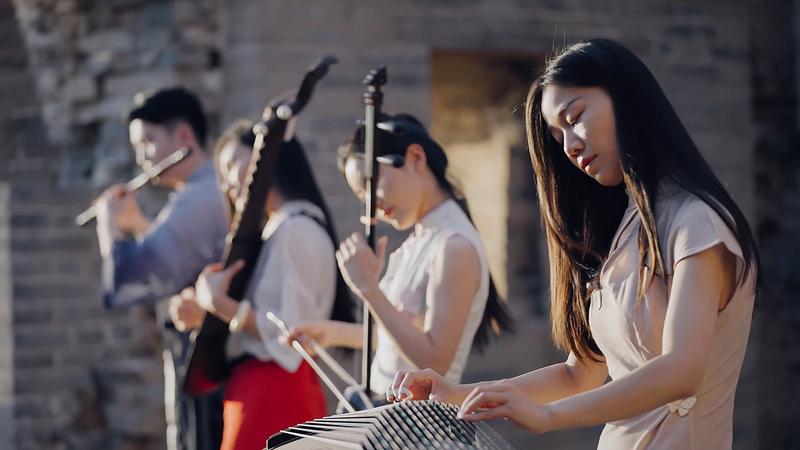Technology allows a new generation to appreciate the sounds of their heritage, Chen Nan reports.
 Musicians perform a piece inspired by Qu Yuan of the Warring States Period (475-221 BC) in a video released in June, marking the Dragon Boat Festival that is to commemorate the poet. (PHOTO PROVIDED TO CHINA DAILY)
Musicians perform a piece inspired by Qu Yuan of the Warring States Period (475-221 BC) in a video released in June, marking the Dragon Boat Festival that is to commemorate the poet. (PHOTO PROVIDED TO CHINA DAILY)
The internet has many Chinese musicians covering the song The Wind Rises, which was originally written and performed by Japanese singer-songwriter Takahashi Yuu.
From pop stars like Greeny Wu Tsing-fong to children performing the song a cappella, numerous artists have attempted to interpret the song in their own way.
In November 2020, a video of four young students from the Sichuan Conservatory of Music, who play traditional Chinese musical instruments: pipa (plucked lute), guzheng (Chinese zither), erhu (two-stringed fiddle) and dizi (Chinese flute), performing the song on the helipad of a skyscraper in Chengdu, Sichuan province, was shared on social media.
Within three hours after the release, the video had been viewed more than 2 million times on short-video sharing platform Douyin. In 24 hours, the video had notched up over 10 million views on social media.
 Musicians on the Great Wall. (PHOTO PROVIDED TO CHINA DAILY)
Musicians on the Great Wall. (PHOTO PROVIDED TO CHINA DAILY)
Because viewers expressed their interest in the video, which combined the beautiful ballad with aerial views of Chengdu, the team released more videos in a series under the title "Crazy Folk".
So far, 125 videos have been released, taking audiences to more Chinese cities, such as Changsha in Hunan province, Luoyang in Henan province and Xiamen in Fujian province. The series of Crazy Folk videos has featured more than 200 Chinese musicians from over 20 Chinese cities.
Besides the erhu, guzheng and pipa, the videos also feature some rarely seen traditional instruments, such as xun. This is a type of wind instrument and one of the oldest musical instruments discovered in China, with a history stretching back more than 7,000 years. And the video also features ruan, a plucked stringed instrument dating back to the Qin Dynasty (221-206 BC).
They performed as ensembles and covered pop songs, such as Mohe Ballroom, originally performed and written by singersongwriter Liu Shuang; Somewhere in Time, originally written and performed by Accusefive, a pop-rock band from Taiwan; and Dao Xiang (Fragrant Rice), originally performed and written by Taiwan pop star Jay Chou.
 Musicians on the Great Wall. (PHOTO PROVIDED TO CHINA DAILY)
Musicians on the Great Wall. (PHOTO PROVIDED TO CHINA DAILY)
The videos struck a chord with music lovers, especially young people, with 60 million views.
"The music is so cool. You successfully changed my impression about traditional Chinese music," comments one viewer on video-sharing platform Bilibili. "I want to learn to play those instruments myself."
Besides domestic social media, Crazy Folk videos have also been uploaded to overseas platforms, such as YouTube.
"I know I am late to the party but wow, this is amazing! Simply beautiful. I love how the instruments are blended together," comments one YouTube viewer.
That is the exact feedback that the players were hoping to get from the audience, according to Li Haoyan, one of the team members behind the Crazy Folk videos.
All of the team members are in their late 20s and early 30s, Li adds.
"The musicians just tried to play the music and explain how versatile and fun traditional Chinese music can be," Li says. "We are happy that many people have enjoyed the videos and have become interested in traditional music."
Li works with a professional video production team headquartered in Chengdu. She lives in the city and enjoys the lifestyle, food, culture and history. Due to the ongoing COVID-19 pandemic, which has disrupted regular daily life, Li and her team started to think about making entertaining and creative videos about the city.
"Traditional Chinese music is very expressive. Besides the music, those instruments are also visually appealing to the audience," says Li.
 Guzheng players perform in the Crazy Folk video series. (PHOTO PROVIDED TO CHINA DAILY)
Guzheng players perform in the Crazy Folk video series. (PHOTO PROVIDED TO CHINA DAILY)
The process of making a video involves selecting a song, a shooting location and costumes for the musicians, who either dress like people from ancient China or put on contemporary clothes.
Besides popular songs, the team also produced works for special occasions, such as traditional festivals and the 24 solar terms on the Chinese calendar.
Li adds that more young people are showing an interest and passion for traditional culture, which inspires her team to come up with more video ideas, such as telling historical stories, introducing museums and cultural relics by fusing them with the latest technology, like artificial intelligence.
"People in the traditional music world are constantly trying to come up with new ways to promote the genre. The idea of the Crazy Folk videos is to help open people's minds to traditional music. With each new video, you never know which song will be performed, by which musical instruments or in which city," says pipa player Li Yang, one of the musicians who participated in the Crazy Folk videos.
One of her favorites features the song Faraway, adapted from the pop song by Jay Chou. The video was released on Sept 10, marking the Mid-Autumn Festival, the 15th day of the eighth lunar month, a traditional Chinese festival.
"We climbed up the Great Wall with our instruments and waited for the sunset to shoot the video, which was very romantic," says the pipa player, who performed the song with other musicians on instruments such as erhu and guzheng. "We repeated the performance over 10 times and it was dark when we finished shooting. It was exhausting but exciting."
"For many people, the repertories for traditional music are limited," says one Crazy Folk participant who goes by the name Nanxiao Yizhu on social media and plays the xiao, a type of vertical flute. "Only a few pieces can be recognized, such as 100 Birds Paying Homage to the Phoenix and Ambush From All Sides. Traditional musical instruments are also considered to be old and out-of-date."
The type of xiao he plays is called nanxiao, which is popular in southern cities. Born into a musical family, which has a long history of playing and making nanxiao, he learned to play the instrument and the dizi as a child. He didn't take on a career as a full-time musician until 2020.
"Visually, the videos are enjoyable to watch. The music is fresh and intriguing for the audience, who might not be familiar with traditional music," he says.
Contact the writer at chennan@chinadaily.com.cn


